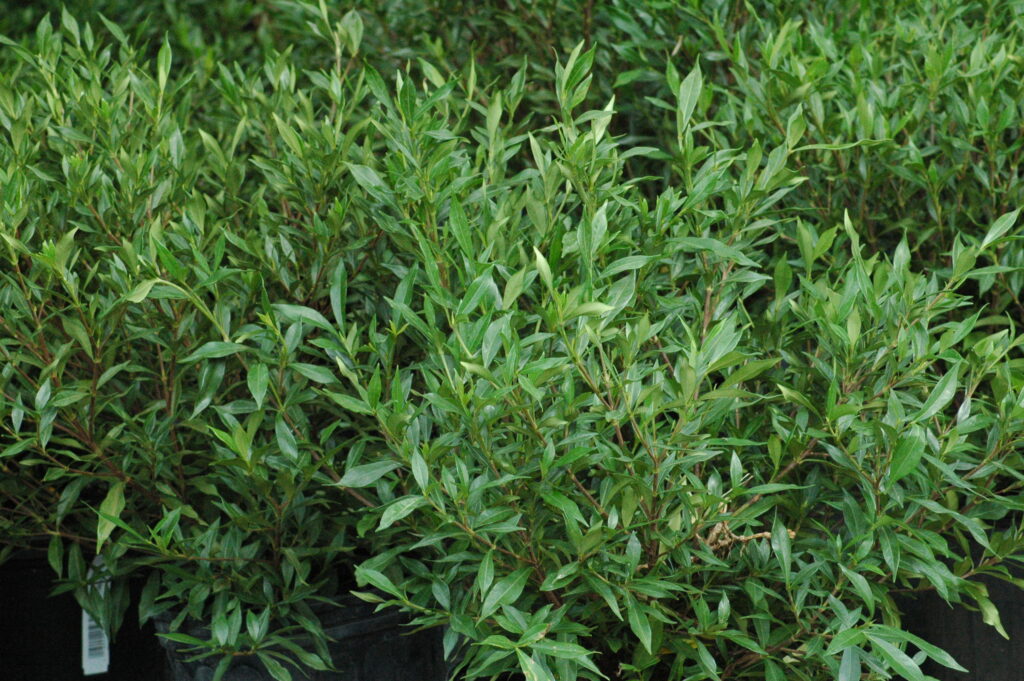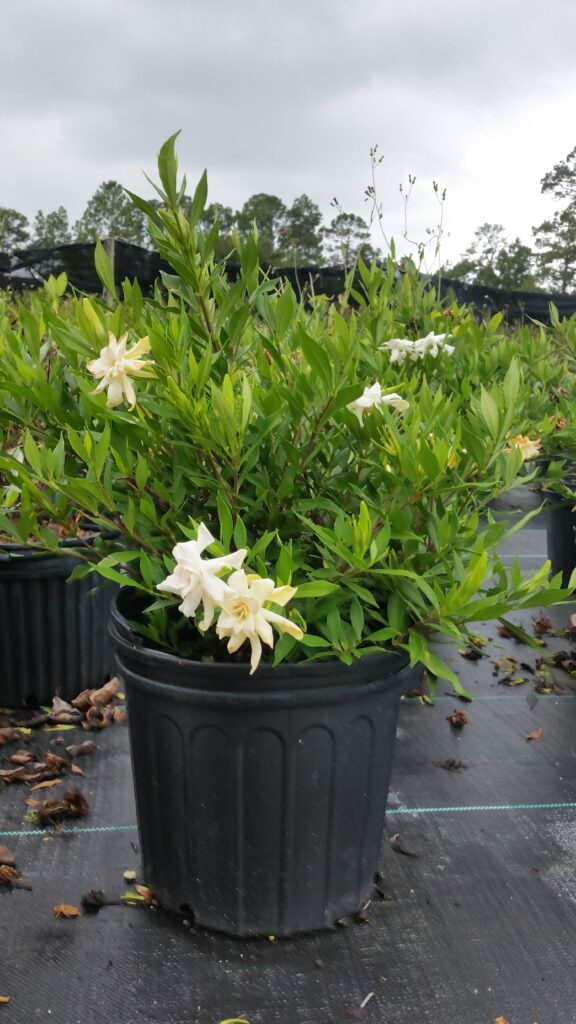Gardenia Frostproof
for Northeast Florida,
Jacksonville | St. Augustine area Landscapes
( Gardenia jasminoides ‘Frostproof’)

Origins and Uses of Gardenia ‘Frostproof’ :
– Gardenias are native to subtropical and tropical portions of Africa, Asia, Madagascar and Australia. Gardenias have been a part of American gardens for over 250 years, since plants were first brought to Charleston, South Carolina from China. Indeed, even their name is American, since the botanist John Ellis had the plant named after his friend and fellow naturalist Dr. Alexander Garden, who had a medical practice in Charleston. Its chief propose for early cultivation was for the cut flower industry as a heavy fragrance corsage. Its popularity meant that it quickly spread across the South and has become a symbol of Southern life. Gardenia jasminoides is perhaps the most famous species of Gardenia boasting over a dozen cultivars. Similar to the parent species the ‘Frostproof‘ is an evergreen shrub having more upright habit and more tolerant of direct sun exposure than other gardenias, with flower buds that resist late spring frosts without damage.
– Gardenias blooming year after year, bringing lovely color, texture and fragrance to your garden.
– Plant Frostproof in strategic places where you and your guests can enjoy it most…in transition areas (entry to a gazebo, doorways, a gate), near a deck or walkway.
– The perfect plant for filling blank walls of foundation planting adjacent to doors and windows that let the fragrance in. Enjoy the same as a sideyard filler. Large enough to be an informal hedge or screen at outdoor living areas, porch or patio and even around a spa. Exceptional background plant for Asian inspired garden design. Works just as well in tropical garden often wanting for flowers. Frostproof Gardenia has been used by modern garden designers for courtyards and in enclosed areas to capture its essence.
Preferred Exposure for Gardenia ‘Frostproof’ :
– In the North Florida | Jacksonville | St. Augustine area morning sun and afternoon shade is preferred by these gardenia although they can handle more sun than most. If grown in hotter climates the leaves may scorch and the flower buds may fall off, so they are best planted in an area that gets full morning sun and afternoon shade. A spot along the eastern or southeastern part of the yard may be the perfect place for your gardenia. If grown in colder climates ‘Frostproof’ they will enjoy a spot in full sun especially if the roots are covered with a layer of organic mulch.
Foliage of the Gardenia ‘Frostproof’ :
– The Small evergreen foliage of the Gardenia ‘Frostproof’ is narrow, dark green, and glossy and are deer resistant .The main draw of ‘Frostproof’ is its slightly higher frost tolerance, allowing it to be planted in USDA hardiness zones 7 to 10, whereas normal cape jasmine has a range of zones 8 to 11.
– Adds texture to the garden and contrasts well with larger foliage plants.
Soil Preference and Salt tolerance of Gardenia ‘Frostproof’ :
– Gardenias need acidic soil with a pH between 5 and 6.5 for optimal growth in our North Florida | Jacksonville | St. Augustine area. They prefer well-drained, organic soil and regular irrigation. Gardenias have shallow roots that can be damaged by cultivation.
– Not particular about soil components and grow equally as well in sandy soils as they do in clay.
– Take care when planting near newly poured concrete surfaces; the leeching is usually alkaline and will raise the pH of the soil.
– Gardenia August Beauty shrubs have a low salt tolerance and should be avoided for coastal plantings.
Size Variance of Gardenia Frostproof :
– Growing up to 4-5 ft tall and 3-4 ft wide. Can be maintained at 2′- 3′ with annual pruning. These are perfectly sized for any application in the landscape.
– When allowed to grow to its full height of five feet, it could be the most fragrant hedge in the neighborhood as well making a great privacy hedge.
– For a formal hedge, space plants 3 to 4 feet apart center-to-center. For a more informal planting, place shrubs at least five feet apart on-center.
Growth Habit of Gardenia Frostproof :
– Grows more upright and bushy with a more compact growth habit.
– Prune back in late winter to promote a compact growth.

Growth Rate of the Gardenia Frostproof :
– Moderate growth rate , growing up to 12″ per year.
Blooms of the Gardenia Frostproof :
– Gardenia has amazing features that it gleefully disperses throughout the garden and a fragrant addition in the cutting garden. Blooming in early summer and then occasionally throughout the fall as well!
– The blooms are double flowered and 2-3” wide . The fragrant flowers not only contrast beautifully with the plant’s foliage but produce a sweet, heady scent.
Water Requirements of Gardenia Frostproof :
– Gardenia Frostproof in the North Florida | Jacksonville | St. Augustine area require soil that is moist and well drained. Try not to let it dry out between watering and ensuring the soil stays consistently moist but not too wet. This stresses the plant. You can rely upon natural rainfall, but use a rain gauge to measure the rain your gardenia receives, and if it’s less than an inch per week supplement it with water from the hose or a watering can.
Butterfly or Bird Attracting:
– Attracts butterflies and other pollinators to the garden.
Care of S & J Nursery’s North Florida | Jacksonville | St. Augustine Gardenia
Shrubs:
– Feed with an acid fertilizer after bloom- Apply fertilizer once in the spring after the threat of frost has passed, and again six weeks later.
– Gardenias use a lot of nutrients to produce so many glorious blossoms. Feed your shrubs by applying an acidic, slow-release fertilizer such as an azalea or camellia fertilizer.
– For the organic gardener, add plenty of lime-free organic material when preparing the planting spot (Lime serves the opposite purpose; it improves soil alkalinity—not acidity). Well-rotted pine-bark, blood meal, fish emulsion or bone meal work well.
– Even if you find your soil is not acidic enough you can still grow the Frost Proof Gardenia by using a special fertilizer called chelated iron, which you water onto your plant and soil in spring and again in late summer. This will provide the iron your plant needs to keep the leaves a rich, dark green and to keep it strong, healthy and flowering well.
– Add a layer of composted plant material or cow manure and top with a layer of mulch to add nutrients to the soil and keep it moist.
– Amend sandy soils generously with a good quality compost when planting to help your Gardenia plants get established quickly.
Here is a link to S & J Tree Farm and Nursery Guide to Planting Your Plants into their New Home
– Water every day during the establishment period after planting in the garden from an S & J Nursery container. Be sure to continue supplemental irrigation during the hot summer months during prolonged droughts. Here is a link for S & J Tree Farm and Nursery’s information on how to water your newly installed plantings in the Northeast Florida landscape.
– Fertilize once each season. Gardenias are heavy feeders and it takes a lot of nutrients to make all those big beautiful flowers. Fertilize with ACID LOVING plant food in early spring, early summer and early fall. I like to use Hollytone or Osmocote for Azaleas and Camellias, (the purple label).
– Mulch thickly at least once a year with arborist wood chips Pine bark or pine straw. Pine Straw is my personal favorite but all of these break down quickly in the landscape, aid in moisture retention and improve the soil structure over time.
– Make your last summer pruning in August or September giving your Gardenia plant ample time to recover growing new foliage that will harden off before winter arrives for us here in late December. Pruning too late into the fall will cause flushes of cold sensitive new growth that can freeze during a heavy frost. If you get tip burn, wait until all danger of frost has past for your area and trim below the damaged tips.

